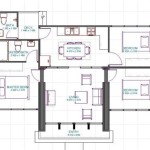A Deep Dive into the Essential Aspects of Rose Seidler House Floor Plan
The Rose Seidler House, designed by renowned Australian architect Harry Seidler, stands as a testament to the principles of modernism and functionalism. Completed in 1950, the house features a carefully considered floor plan that maximizes space and natural light while blurring the boundaries between indoor and outdoor living.
Open-Plan Living
The house's most striking feature is its open-plan living area, which combines the living, dining, and kitchen spaces into a single, expansive room. This design element creates a sense of openness and fluidity, allowing the free movement of light and air throughout the space.
Asymmetrical Facade
Externally, the house is characterized by its asymmetrical facade, which features a combination of glass, timber, and brick. This facade visually reflects the open-plan layout within, with the living area extending outwards towards the garden through large glass windows.
Indoor-Outdoor Connection
The floor plan seamlessly integrates the indoor and outdoor spaces, creating a strong connection between the two. Large sliding glass doors connect the living area to the courtyard, allowing the inhabitants to enjoy the natural surroundings while still maintaining shelter. The courtyard, with its lush greenery and water feature, becomes an extension of the living space.
Functional Zones
Despite its open plan, the floor plan cleverly divides the house into distinct functional zones. The master bedroom is located on the ground floor, offering privacy and seclusion, while the two additional bedrooms and study occupy the mezzanine level overlooking the living area. This arrangement ensures that each space maintains its own privacy and function.
Natural Light
Natural light plays a crucial role in the house's design, with large windows and glazed walls flooding the spaces with sunlight. The orientation of the house maximizes natural light exposure, creating a bright and airy interior that enhances the sense of spaciousness.
Cross Ventilation
In addition to natural light, the floor plan emphasizes cross ventilation, which helps circulate fresh air through the house and reduce the need for artificial cooling. Openings on opposite sides of the house allow air to flow freely, creating a comfortable and healthy living environment.
Influence of Le Corbusier
The Rose Seidler House bears clear influences of the work of Swiss-French architect Le Corbusier, particularly his Five Points of Architecture. The open plan, pilotis (support columns), ribbon windows, and rooftop garden are all elements that reflect Corbusier's principles of modern architecture.
Legacy and Impact
The Rose Seidler House remains an icon of Australian modernism and has had a profound impact on the development of residential architecture in the country. Its innovative design and functional floor plan continue to inspire architects and designers to this day.

Rose Seidler House Wahroonga Sydney

Rose Seidler House A 1950 Modern Classic Simple Floor Plans Architecture

Floor Plane And Elevation For Rose Seidler House Planimetrie Di Case Moderni Progetti Casa Piano Architettura

Canberra House 11 Northcote Crescent Deakin 1951 52

Rose Seidler House Final Project Kiến Trúc Bản Vẽ

Rose Seidler House
Architectural Communications The Final Project Rose Seidler House

Thermal Nationalism The Climate And House Design Program In 1944 1960

Rose Seidler House Wahroonga

Rose House








